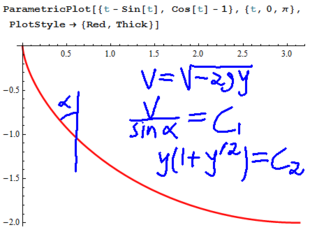| Additions to this web site no longer count towards good deed points.
|
| #
|
Week of...
|
Notes and Links
|
| 1
|
Sep 10
|
About This Class.  Monday: Introduction and the Brachistochrone. Monday: Introduction and the Brachistochrone.  Tuesday: More on the Brachistochrone, administrative issues. Tuesday Notes. Tuesday: More on the Brachistochrone, administrative issues. Tuesday Notes.  Friday: Some basic techniques: first order linear equations. Friday: Some basic techniques: first order linear equations.
|
| 2
|
Sep 17
|
 Monday: Separated equations, escape velocities. HW1. Monday: Separated equations, escape velocities. HW1.  Tuesday: Escape velocities, changing source and target coordinates, homogeneous equations. Tuesday: Escape velocities, changing source and target coordinates, homogeneous equations.  Friday: Reverse engineering separated and exact equations. Friday: Reverse engineering separated and exact equations.
|
| 3
|
Sep 24
|
 Monday: Solving exact equations, integration factors. HW2. Monday: Solving exact equations, integration factors. HW2.  Tuesday: Statement of the Fundamental Theorem. Class Photo. Tuesday: Statement of the Fundamental Theorem. Class Photo.  Friday: Proof of the Fundamental Theorem. Friday: Proof of the Fundamental Theorem.
|
| 4
|
Oct 1
|
 Monday: Last notes on the fundamental theorem. HW3. Monday: Last notes on the fundamental theorem. HW3.  Tuesday Hour 1: The chain law, examples of variational problems. Tuesday Hour 1: The chain law, examples of variational problems.  Tuesday Hour 2: Deriving Euler-Lagrange. Tuesday Hour 2: Deriving Euler-Lagrange.  Friday: Reductions of Euler-Lagrange. Friday: Reductions of Euler-Lagrange.
|
| 5
|
Oct 8
|
Monday is thanksgiving.  Tuesday: Lagrange multiplyers and the isoperimetric inequality. HW4. Tuesday: Lagrange multiplyers and the isoperimetric inequality. HW4.  Friday: More Lagrange multipliers, numerical methods. Friday: More Lagrange multipliers, numerical methods.
|
| 6
|
Oct 15
|
 Monday: Euler and improved Euler. Monday: Euler and improved Euler.  Tuesday: Evaluating the local error, Runge-Kutta, and a comparison of methods. Tuesday: Evaluating the local error, Runge-Kutta, and a comparison of methods.  Friday: Numerical integration, high order constant coefficient homogeneous linear ODEs. Friday: Numerical integration, high order constant coefficient homogeneous linear ODEs.
|
| 7
|
Oct 22
|
 Monday: Multiple roots, reduction of order, undetermined coefficients. Monday: Multiple roots, reduction of order, undetermined coefficients.  Tuesday: From systems to matrix exponentiation. HW5. Term Test on Friday. Tuesday: From systems to matrix exponentiation. HW5. Term Test on Friday.
|
| 8
|
Oct 29
|
 Monday: The basic properties of matrix exponentiation. Monday: The basic properties of matrix exponentiation.  Tuesday: Matrix exponentiation: examples. Tuesday: Matrix exponentiation: examples.  Friday: Phase Portraits. HW6. Nov 4 was the last day to drop this class Friday: Phase Portraits. HW6. Nov 4 was the last day to drop this class
|
| 9
|
Nov 5
|
 Monday: Non-homogeneous systems. Monday: Non-homogeneous systems.  Tuesday: The Catalan numbers, power series, and ODEs. Tuesday: The Catalan numbers, power series, and ODEs.  Friday: Global existence for linear ODEs, the Wronskian. Friday: Global existence for linear ODEs, the Wronskian.
|
| 10
|
Nov 12
|
Monday-Tuesday is UofT November break. HW7.  Friday: Series solutions for Friday: Series solutions for  . .
|
| 11
|
Nov 19
|
 Monday: Monday:  is irrational, more on the radius of convergence. is irrational, more on the radius of convergence.  Tuesday (class): Airy's equation, Fuchs' theorem. Tuesday (class): Airy's equation, Fuchs' theorem.  Tuesday (tutorial): Regular singular points. HW8. Tuesday (tutorial): Regular singular points. HW8.  Friday: Discussion of regular singular points.. Friday: Discussion of regular singular points..
|
| 12
|
Nov 26
|
 Monday: Frobenius series by computer. Qualitative Analysis Handout (PDF). Monday: Frobenius series by computer. Qualitative Analysis Handout (PDF).  Tuesday: The basic oscillation theorem. Handout on the Frobenius Method. HW9. Tuesday: The basic oscillation theorem. Handout on the Frobenius Method. HW9.  Friday: Non-oscillation, Sturm comparison. Friday: Non-oscillation, Sturm comparison.
|
| 13
|
Dec 3
|
 Monday: More Sturm comparisons, changing the independent variable. Monday: More Sturm comparisons, changing the independent variable.  Tuesday: Amplitudes of oscillations. Last class was on Tuesday! Tuesday: Amplitudes of oscillations. Last class was on Tuesday!
|
| F1
|
Dec 10
|
|
| F2
|
Dec 17
|
The Final Exam (time, place, style, office hours times)
|
| Register of Good Deeds
|

Add your name / see who's in!
|

|
|
Solving the complicated integral in the Brachistochroe integral
integral sqrt((d-y)/y) dy
= integral sqrt(d y-y^2)/y dy
For the integrand sqrt(d y-y^2)/y, complete the square:
= integral sqrt(d^2/4-(y-d/2)^2)/y dy
For the integrand sqrt(d^2/4-(y-d/2)^2)/y, substitute u = y-d/2 and du = dy:
= integral (2 sqrt(d^2/4-u^2))/(d+2 u) du
= 2 integral sqrt(d^2/4-u^2)/(d+2 u) du
For the integrand sqrt(d^2/4-u^2)/(d+2 u), (assuming all variables are positive) substitute u = 1/2 d sin(s) and du = 1/2 d cos(s) ds. Then sqrt(d^2/4-u^2) = sqrt(d^2/4-1/4 d^2 sin^2(s)) = 1/2 d cos(s) and s = sin^(-1)((2 u)/d):
= d^2/2 integral (cos^2(s))/(d sin(s)+d) ds
For the integrand (cos^2(s))/(d sin(s)+d), substitute p = tan(s/2) and dp = 1/2 sec^2(s/2) ds. Then transform the integrand using the substitutions sin(s) = (2 p)/(p^2+1), cos(s) = (1-p^2)/(p^2+1) and ds = (2 dp)/(p^2+1):
= d^2/2 integral (2 (1-p^2)^2)/((p^2+1)^3 ((2 d p)/(p^2+1)+d)) dp
Simplify the integrand (2 (1-p^2)^2)/((p^2+1)^3 ((2 d p)/(p^2+1)+d)) to get (2 (p-1)^2)/(d p^4+2 d p^2+d):
= d^2/2 integral (2 (p-1)^2)/(d p^4+2 d p^2+d) dp
= d^2 integral (p-1)^2/(d p^4+2 d p^2+d) dp
= d^2 integral (p-1)^2/(d (p^2+1)^2) dp
= d integral (p-1)^2/(p^2+1)^2 dp
For the integrand (p-1)^2/(p^2+1)^2, use partial fractions:
= d integral (1/(p^2+1)-(2 p)/(p^2+1)^2) dp
= d integral 1/(p^2+1) dp-2 d integral p/(p^2+1)^2 dp
For the integrand p/(p^2+1)^2, substitute w = p^2+1 and dw = 2 p dp:
= d integral 1/(p^2+1) dp-d integral 1/w^2 dw
The integral of 1/(p^2+1) is tan^(-1)(p):
= d tan^(-1)(p)-d integral 1/w^2 dw
= d tan^(-1)(p)+d/w+constant
Substitute back for w = p^2+1:
= (d ((p^2+1) tan^(-1)(p)+1))/(p^2+1)+C
Substitute back for p = tan(s/2):
= 1/2 d (cos(s)+2 tan^(-1)(tan(s/2))+1)+C
Substitute back for s = sin^(-1)((2 u)/d):
= 1/2 (sqrt(d^2-4 u^2)+2 d tan^(-1)((2 u)/(d (sqrt(1-(4 u^2)/d^2)+1)))+d)+C
Substitute back for u = y-d/2:
= d (-tan^(-1)((d-2 y)/(2 d sqrt((y (d-y))/d^2)+d)))+sqrt(y (d-y))+d/2+C
Factor the answer a different way:
= 1/2 (-2 d tan^(-1)((d-2 y)/(2 d sqrt((y (d-y))/d^2)+d))+2 sqrt(y (d-y))+d)+C
Which is equivalent for restricted y and d values to:
= y sqrt(d/y-1)-1/2 d tan^(-1)((sqrt(d/y-1) (d-2 y))/(2 (d-y)))+C
Syjytg 23:00, 11 September 2012 (EDT)



